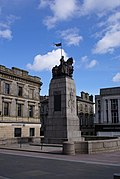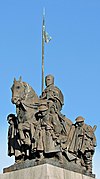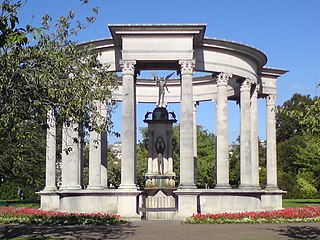
The Welsh National War Memorial is situated in Alexandra Gardens, Cathays Park, Cardiff. The memorial was designed by Sir Ninian Comper and unveiled on 12 June 1928 by the Prince of Wales. The memorial commemorates the servicemen who died during the First World War and has a commemorative plaque for those who died during the Second World War, added in 1949.

The Sydney Cenotaph is a heritage-listed monument located in Martin Place, in Sydney, New South Wales, Australia. It was designed by Bertram Mackennal and built from 1927 to 1929 by Dorman Long & Co. It is also known as Martin Place Memorial and The Cenotaph. It is one of the oldest World War I monuments in central Sydney. It was added to the New South Wales State Heritage Register on 11 November 2009.
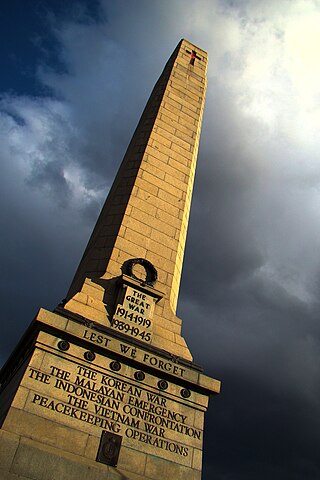
Hobart Cenotaph is the main commemorative military monument for the Australian state of Tasmania. It is located in the capital Hobart in a prominent position on the Queens Domain, on a small rise overlooking the city and River Derwent. The Cenotaph sits directly above what was once the location of the Queens Battery.
William Birnie Rhind RSA (1853–1933) was a Scottish sculptor.

The Belfast Cenotaph is a war memorial in Belfast, Northern Ireland, in Donegall Square West, to the west of Belfast City Hall. Like the City Hall, it was designed by Sir Alfred Brumwell Thomas. The cenotaph was unveiled in 1929. It became a Grade A listed building in 1984.

Manchester Cenotaph is a war memorial in St Peter's Square, Manchester, England. Manchester was late in commissioning a First World War memorial compared with most British towns and cities; the city council did not convene a war memorial committee until 1922. The committee quickly achieved its target of raising £10,000 but finding a suitable location for the monument proved controversial. The preferred site in Albert Square would have required the removal and relocation of other statues and monuments, and was opposed by the city's artistic bodies. The next choice was Piccadilly Gardens, an area already identified for a possible art gallery and library; but in the interests of speedier delivery, the memorial committee settled on St Peter's Square. The area within the square had been had been purchased by the City Council in 1906, having been the site of the former St Peter's Church; whose sealed burial crypts remained with burials untouched and marked above ground by a memorial stone cross. Negotiations to remove these stalled so the construction of the cenotaph proceeded with the cross and burials in situ.
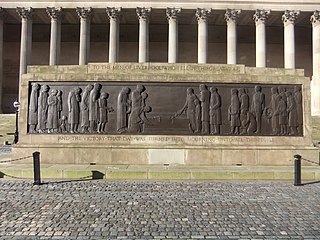
Liverpool Cenotaph stands on St George's Plateau, to the east of St George's Hall in Liverpool, England. It was erected as a memorial to those who had fallen in the First World War. The dates of the Second World War were subsequently added. The cenotaph consists of a rectangular block of stone on a stone platform, with bronze, low-relief sculptures on the sides depicting marching troops and mourners. It was designed by Lionel Budden, with carving by Herbert Tyson Smith. Initially designated as a Grade II listed building, its status was raised to Grade I in 2013.

Widnes War Memorial stands in Victoria Park, Widnes, Cheshire, England. It commemorates the serving men who lost their lives in the two world wars. The memorial consists of an obelisk in Portland stone on a plinth of York stone. It was unveiled in 1921, and more names were added in 1950. The monument is recorded in the National Heritage List for England as a designated Grade II listed building.

Gertrude Alice Meredith Williams, who generally went by the name of Alice Meredith Williams, was a British sculptor, painter, illustrator and stained glass designer.
Charles d’Orville Pilkington Jackson RSA, FRBS, FRSA was a British sculptor prominent in Scotland in the 20th century. Throughout his career he worked closely with the architect Sir Robert Lorimer. He is most noteworthy for his creation of one of Scotland's most iconic landmarks, the statue of Robert the Bruce at Bannockburn.

The statue of the Earl Kitchener is an outdoor bronze statue by John Tweed depicting Herbert Kitchener, 1st Earl Kitchener, installed in 1926 and located on the south side of Horse Guards Parade in London, United Kingdom. The sculpture stands on a Portland stone plinth. It became a Grade II listed building in 1970.

Lewes War Memorial is a war memorial at the top of School Hill in the centre of Lewes in East Sussex, prominently sited at the junction of High Street and Market Street. It commemorates 251 men from Lewes who died in the First World War, and 126 who died in the Second World War. It was unveiled in 1922 and became a listed building in 1985.
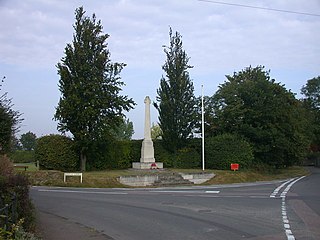
Ashwell War Memorial is a war memorial cross in the village of Ashwell in North Hertfordshire, England. The memorial was designed by Sir Edwin Lutyens and unveiled in 1922, one of 15 war crosses designed by Lutyens to similar designs erected between 1920 and 1925. It is a Grade II listed building.

The Cameronians War Memorial is a war memorial in Kelvingrove Park in the west of Glasgow, Scotland, to the north of Kelvingrove Art Gallery and Museum. It commemorates the service of the Cameronians regiment in the First and Second World Wars. The memorial includes a bronze sculpture representing a machine gun emplacement, with three human figures. It became a Category B listed building in 1988.

The Royal Artillery Boer War Memorial is located on the south side of The Mall in Central London, close to the junction with Horse Guards Road at the northeast corner of St James's Park. Unveiled in 1910, it marks the deaths of the 1,083 soldiers of the Royal Artillery who died in the Second Boer War from 1899 to 1902 It has been a listed building since 1970.

Bristol Cenotaph is a war memorial at the north end of Magpie Park, in Bristol, erected in 1932. It is a Grade II listed building.

The County Fermanagh War Memorial stands in Enniskillen, County Fermanagh, Northern Ireland. It was originally constructed to commemorate the men of the town killed during the First World War, particularly those serving with the local regiments, the 6th (Inniskilling) Dragoons and the Royal Inniskilling Fusiliers. It was later altered to also commemorate those killed in the Second World War.

Swansea War Memorial, also known as Swansea Cenotaph, is a war memorial on the promenade beside Mumbles Road, the A4067, near Brynmill to the southwest of Swansea city centre, overlooking Swansea Beach and Swansea Bay.
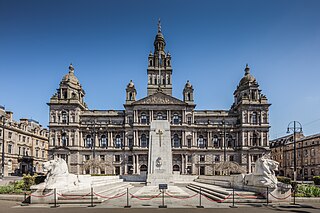
Glasgow Cenotaph, also known as Glasgow War Memorial, is a war memorial which stands on the east side of George Square in Glasgow, in front of Glasgow City Chambers. It was originally constructed to commemorate Glaswegians killed during the First World War, and was unveiled by Field Marshal Douglas Haig, 1st Earl Haig in 1924. Further inscriptions were added after the Second World War, and the memorial became a Grade B listed building in 1970.

The Worcester Boer War Memorial in Worcester, England, was unveiled near Worcester Cathedral in 1908. The war memorial commemorates casualties of the Second Boer War from the county of Worcestershire. It was designated a Grade II* listed building in 1999.

